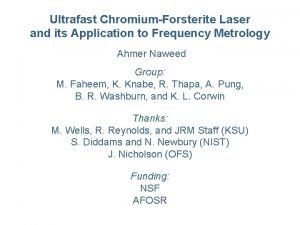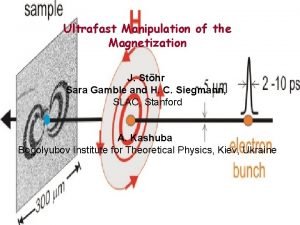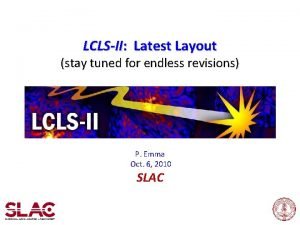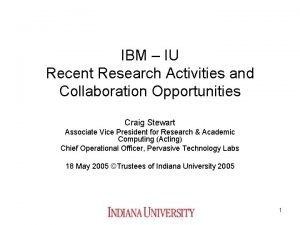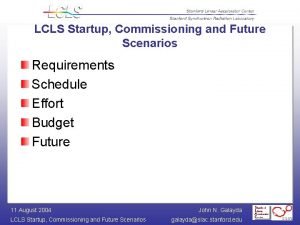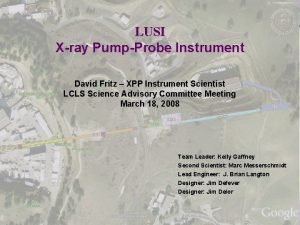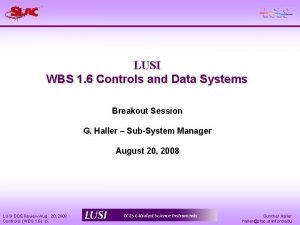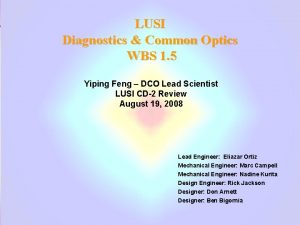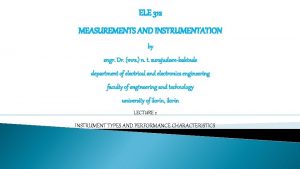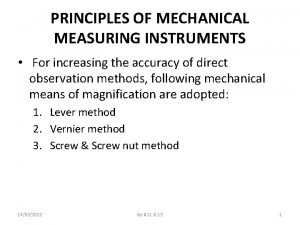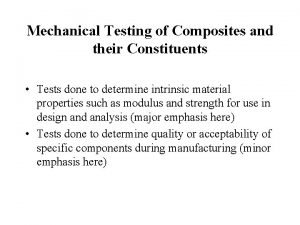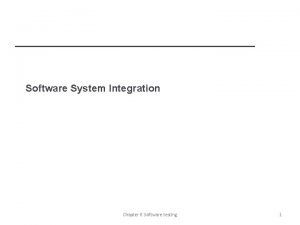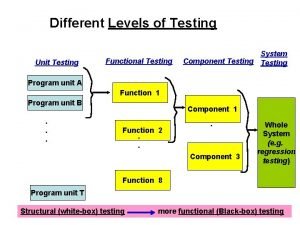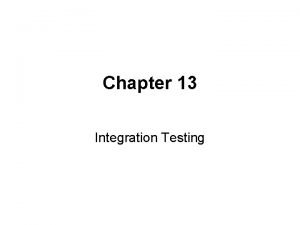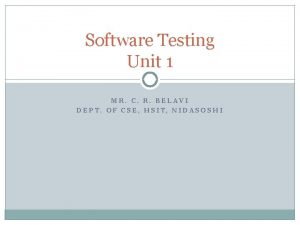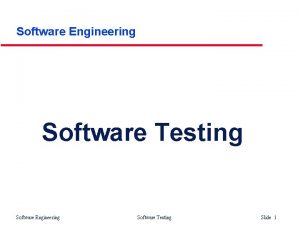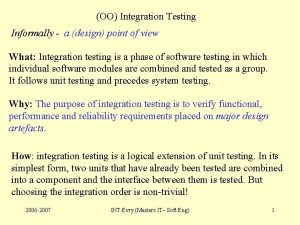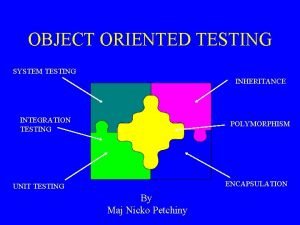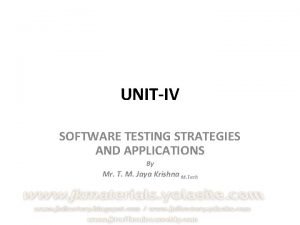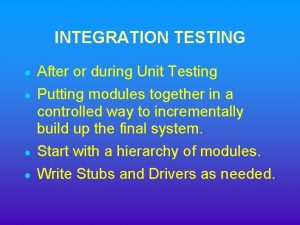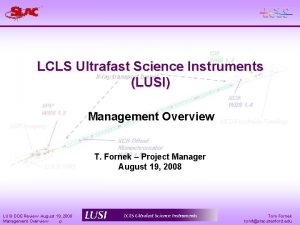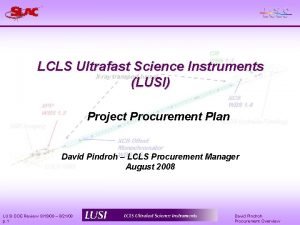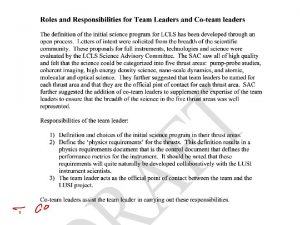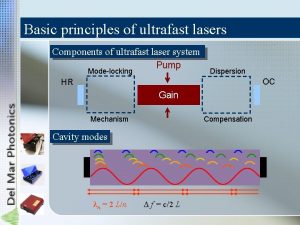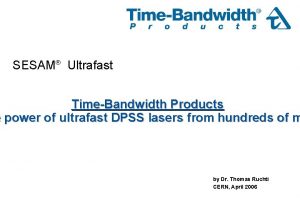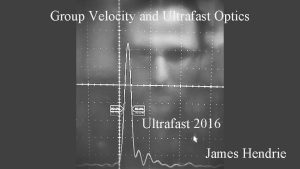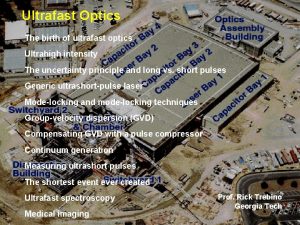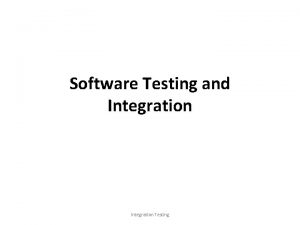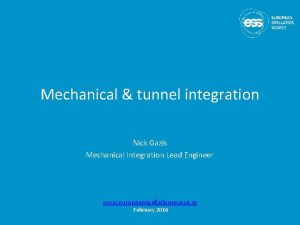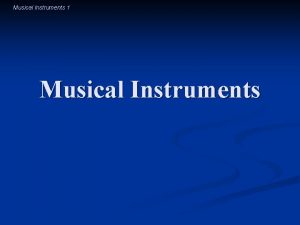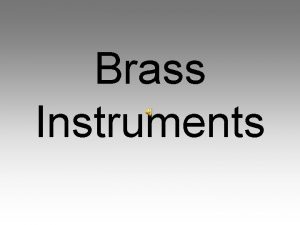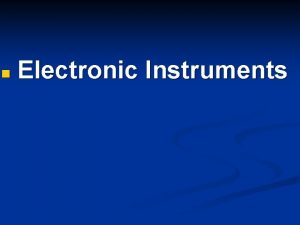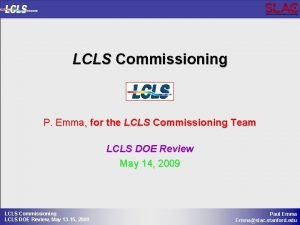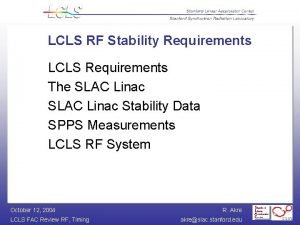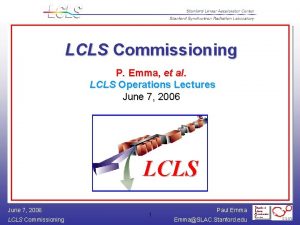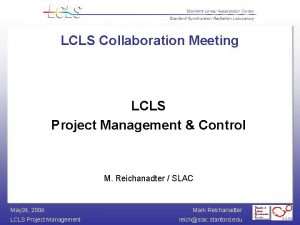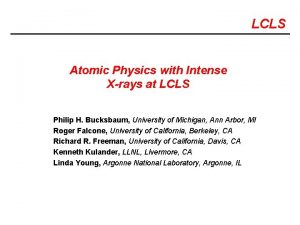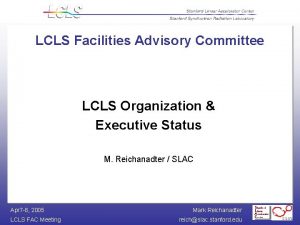LUSI LCLS Ultrafast Science Instruments Mechanical Integration Testing












































- Slides: 44

LUSI, LCLS Ultrafast Science Instruments Mechanical Integration, Testing and Delivery of the Large Area Telescope (LAT) for the GLAST program June 26, 2008 Eliazar Ortiz

Personal Background School: Ø 1996, B. S. Aerospace Engineering from SDSU. Ø 2007, M. S. Aerospace Engineering from SJSU Employers: Ø Present SLAC: § LAT Assembly MEIC. § LUSI Diagnostics and Common Optics Lead Engineer Ø 1996 -2003 Space Systems Loral: MVE, R&D engineer Ø 1996 Naval Aviation Depot June 26, 2008 Eliazar Ortiz

Outline Topics: Ø LUSI Overview Ø LUSI Engineering Activities Ø LAT Integration Methodology Ø LAT environmental test Ø LAT integration to Spacecraft Ø LAT Launch June 26, 2008 Eliazar Ortiz

LUSI, LCLS Ultrafast Science Instruments A suite of x-ray instruments for exploiting the unique scientific capability of the Linac Coherent Light Source will be produced by the LUSI project. LUSI hopes to build four instruments over a period of about five years. Two of these instruments will be optimized for hard x-ray studies of ultrafast dynamics at the atomic level, addressing basic problems in chemistry and materials science. A third instrument will concentrate on hard x-ray coherent imaging of nano-particles and large biomolecules. The fourth instrument will give LCLS the capability of using soft x-rays to study magnetic structures and surface chemistry. These instruments will complement other instruments at LCLS, which are directed towards atomic physics and plasma physics. A summary of LCLS scientific applications can be found here. June 26, 2008 Eliazar Ortiz

LUSI Coherent X-ray Imaging Instrument This instrument will take advantage of the extremely bright, ultrashort LCLS pulses of hard x-rays to allow imaging of non-periodic nano-scale objects, including single biomolecules or small clusters, at or near atomic resolution. Particle injector Detector chamber Extension spools Sample chamber KB system Positioning table June 26, 2008 Eliazar Ortiz

LUSI X-Ray Pump-Probe Instrument This instrument, using the ultrabright, ultrashort x-ray pulses from LCLS, will permit a large class of dynamical processes in molecules and condensed matter systems to be studied directly, with atomic spatial resolution and sub-picosecond time resolution. X-ray Photon Correlation Spectroscopy Instrument The unprecedented brilliance and narrow pulse duration of the LCLS provides a unique opportunity to observe dynamical changes of large groups of atoms in condensed matter systems over a wide range of time scales using X-ray Photon Correlation Spectroscopy (XPCS). June 26, 2008 Eliazar Ortiz

LUSI XPP Laser System (Fundamental) Small Angle Scattering Wavelength Conversion X-Ray Pump Probe Layout X-ray Diffractometer Offset Monochromator X-ray Pump-Probe Instrument June 26, 2008 Eliazar Ortiz

LUSI Engineer Ø Reports to Chief Engineer Ø Responsible for all technical aspects of the project Ø Responsible for reporting cost and schedule (earned value) § Control Account Manager (CAM) Ø Responsible for supervising daily activities of subordinate engineers, design engineers and designers Ø Responsible for keeping management informed on critical issues, delays, etc. Ø Works with upper management to make critical decisions June 26, 2008 Eliazar Ortiz

LUSI Instruments Ø Position Monitor & Intensity Monitor Pop-in § Preliminary designs Ø Hard X-Ray Intensity/Position Monitor Intensity Position Monitor June 26, 2008 Pop-in Diode Intensity Monitor Pop-in Position Monitor Eliazar Ortiz

LUSI Instruments Pulse picker, attenuators and X-ray focusing lens designs are working. Ø First article pulse picker purchased Pulse Picker Attenuator June 26, 2008 X-ray Focusing Lens Eliazar Ortiz

LUSI Instruments Harmonic rejection mirror (HRM)& slits Ø HRM conceptual design Ø Slit conceptual design Guard Slits June 26, 2008 Harmonic Rejection Mirror Eliazar Ortiz

LAT Integration Project objective is focused on this phase of the life cycle, “building the LAT” Fig. 1 GLAST System Life Cycle June 26, 2008 Eliazar Ortiz

Integration Phase Many people view the Integration and Test phase of a space program as assembling a huge pile of mechanical and electrical components into a space telescope. They are about 2% correct. The visible part of the space project, the flight hardware, is the tip of an iceberg. Without a massive support structure there wouldn’t be any spacecraft. Some necessary support activities that lead to a finished LAT are: Ø Design of flight hardware Ø Construction of prototype hardware Ø Construction of Flight hardware Ø Testing of Hardware Ø Finished drafting Ø Construction management Ø Construction of test equipment and special facilities Ø Maintaining records Therefore the Integration Lead should have an understanding of the functions of the various subsystems, the trade-offs involved in selection and how they affect each other. June 26, 2008 Eliazar Ortiz

I&T Importance Why is the I&T phase important: ØBecause costly or irreparable damage can occur at any moment: ØSpace News, 23 December 2003: Spain. Sat Damaged, Launch Delayed After Satellite is Dropped ØFLORIDA TODAY, 03 October 2001: CAPE CANAVERAL, Fla. -- A Boeing worker was killed Monday evening while working at Launch Pad 37 at Cape Canaveral Air Force Station, the second death at the site in three months. NOAA-N Prime Polar Orbiter dropped while in integration at I&T facility in Sunnyvale, CA June 26, 2008 Eliazar Ortiz

Integration Facilities for the GLAST LAT I&T Project Operation of the LAT I&T Facility at SLAC: June 26, 2008 Eliazar Ortiz

GLAST Mission: ØGamma-ray Large Area Space Telescope § Energy range: 10 ke. V – 300 Ge. V ØBudget: v Weight: 2782 Kg v Power: 650 W v Cost: 0. 5 B$ ØLaunch: v Launch Date: June 11 2008 v Launch Site: KSC v Vehicle: Delta 2920 -H Rocket ØOrbit: v 565 Km circular v 28. 5° inclination June 26, 2008 Eliazar Ortiz

GLAST Instrumentation: LAT ØLarge Area Telescope (LAT) §Energy Range: 20 Me. V – 300 Ge. V §Field of View (FOV): 2. 4 steradians §Observation Modes: –All sky survey –Pointed observation (Rapid Slew Re-pointing : 75° < 10’) ØGLAST Burst Monitor (GBM) GBM §Correlative observations of transient events: Gamma-ray bursts, afterglows in bursts, … §Energy Range: 10 ke. V - 25 Me. V §FOV: 8 steradians §Observation Modes: –All sky survey: Detect gamma-ray bursts and alert LAT and ground telescopes –Pointed observation: Autonomous Re-point for bright bursts beyond LAT FOV June 26, 2008 Eliazar Ortiz

GLAST LAT Instrumentation: Ø 16 Towers Inserted in Grid § 16 Tracker (TKR): – Detect and convert Gamma-rays § 16 Calorimeter (CAL): – Detect and measure energy of Gamma-rays § 16 Tower Electrical Module/Tower Power Supply (TEM/TPS): – Provide with Power to CAL/TKR Ø Anti-Coincidence Detector (ACD) – Detect and veto charged particles Ø Micro-meteoroid Shield Ø Electromagnetic Interference “Skirt” (EMI) June 26, 2008 Eliazar Ortiz

GLAST LAT Instrumentation (Cont. ): Ø Electronic Modules (ELX): § GASU – Contains Data Acquisition (DAQ) and Processing Modules of the LAT § Power Distribution Unit (PDU) – Manages power budget of the LAT Instrumentation § 3 Event Processing Modules (EPU) – Contains FSW that filters data to be transmitted to ground for analysis § 2 Spacecraft Interface Units (SIU) – Interface LAT with Spacecraft and ground June 26, 2008 Eliazar Ortiz

I&T Objectives: Ø Mechanical integration of the Gamma Ray Large Area Telescope (LAT) Ø Processing through environmental test Ø Timely delivery of the LAT for integration to the spacecraft or satellite “bus”. June 26, 2008 Eliazar Ortiz

LAT Integration The 4 x 4 Grid provides mechanical support and thermal control for the detector array. TKR Modules mount to the upper edge (+Z side) of each bay, while CAL Modules are inserted into –Z side of each bay. Shear plate installation per LAT-PS-03259. June 26, 2008 Single TKR Module being lowered onto the Grid. Two TKRs have already been installed. Empty Grid bays are filled with mass dummies. Installation per LAT-PS-03058 LAT fully populated with TKRs (visible), CALs, and +Z Test instrumentation prior to installation of the ACD. Single CAL Module being inserted into the Grid. CAL and Grid are inverted for this operation. Tower Electronics Module (TEM), which provides readout for an individual CAL+TKR Tower, has been integrated with CAL. Installation of DSHP’s onto GRID per LAT-PS-4911. , Eliazar Ortiz

LAT Integration Cycle Cont. Installation of ACD onto fully populated LAT, per LAT-PS-07240. Shimming of X-Lat plate HP to make them coplanar to the DSHP, per LATPS--04911 June 26, 2008 LAT fully populated with TKRs, CALs (visible), and -Z Test instrumentation prior to installation of the ACD. Ship to NRL Installation of X-LAT plate onto fully populated LAT Environmental Test Processing at NRL, per LAT-PS-07728 Eliazar Ortiz

Environmental Test Processing Environmental Test Phase Cycle Offload & Set-up LAT CPT Sine Vibe 5 days 9 days Install Radiator s 2 days EMI/EMC Test Acoustic Test 11 days 7/07/06 Pre TV T- Bal T- Cycle 40 days CPT 3 days Weight & CG 2 days Remove Radiator s Pack and Ship 2 days 9/16/06 Procedure: LAT-PS-07728 June 26, 2008 Eliazar Ortiz

Sine Vibration Test Configuration -Vertical test configuration June 26, 2008 Eliazar Ortiz

Sine Vibration Test Configuration -Vertical test configuration June 26, 2008 Eliazar Ortiz

Sine Vibration Test Configuration - Horizontal Test Configuration June 26, 2008 Eliazar Ortiz

EMI TEST Purpose Demonstrate LAT complies with all EMI/EMC requirements: Ø Conducted and radiated emissions below required levels Ø LAT does not exhibit susceptibilities when exposed to conducted or radiated energy at required levels Test Categories: Ø Conducted emissions (CE): Measures all power, analogue and digital signals that are conducted via cables, harnesses and structural parts of the instrument. Ø Radiated emissions (RE): Measures all electric or magnetic fields emitted from the equipment. Ø Conducted susceptibility (CS): Measures the ability of the instrument to operate satisfactorily when externally generated conducted interference signals are directly injected into the instrument’s harness cables or structure Ø Radiated susceptibility (RS): Measures the ability of the spacecraft to operate satisfactorily when placed in an environment that contains externally generated electric or magnetic fields. June 26, 2008 Eliazar Ortiz

Radiated susceptibility (RS) RS 101 tested limited locations: Ø Connectors, Tracker RS 103 Test sweeps were performed and data analysis performed off line Ø ACD, CAL and TKR performance verified June 26, 2008 Eliazar Ortiz

Acoustic Test Objectives Ø Demonstrate that the fully integrated LAT is capable of withstanding acoustic noise loads, simulating launch conditions. Pre- and post-test signature overlays show identical structural behavior prior to and after PFQ loads, and performance testing showed no degradation due to acoustic loads Ø A secondary objective is to verify the acoustic analysis, i. e. that the LAT components were qualified to high enough levels of random vibration. The responses show subsystem test level specifications were conservative June 26, 2008 Eliazar Ortiz

LAT Thermal Subsystem Overview Heat pipes Ø Down Spout Heat Pipes connect Grid to Radiators MLI thermal shielding surrounding ACD, Grid Box, Electronics Variable-conductance Heat Pipes § 6 VCHP’s per Radiator panel § Provides feedback control of grid temperature Ø 5 Top Flange Heat Pipes (not shown) § Isothermalize grid structure Ø X-LAT Heat Pipes § Remove waste heat from electronics § Connect radiators for load-sharing Ø Downspout Heat Pipes § Transport waste heat from grid to Radiators Ø Two panels, parallel to the LAT XZ-plane Ø Size per panel: 1. 82 m x 1. 56 m = 2. 84 m 2 Ø Aluminum honeycomb structure X-LAT Heat Pipes shunt electronics power to Radiators Active VCHP control allows for variable Radiator area to maintain constant interface temp to LAT June 26, 2008 LAT Thermal Overview Eliazar Ortiz

Thermal Test Equipment VCHP need to be horizontal to operate w/ gravity for TVAC Need to rotate from +Z vertical orientation to +X vertical orientation CALROD cages (toaster elements) simulate heat loads on radiators (not shown) June 26, 2008 Sink plates w/ heaters simulate solar load on ACD and other components Eliazar Ortiz

Test Overview June 26, 2008 Eliazar Ortiz

Mass Properties Test Configuration Mass Properties Test Objectives Ø Measure the overall mass and CG of the fully integrated LAT Ø Verify the following three requirements: § LAT mass does not exceed 3000 kg. – The mass properties test showed the LAT mass to be 2782 kg (2789 kg predicted) § By Analysis, show Zcg is a maximum of 185 mm above the LAT Interface Plane (LIP). – Will be published in the test report. This is considered very low risk since prediction error is small when compared with measured quantities. § By Test, show X-cg and Y-cg are within 20 mm of the LAT Coordinate System (LCS) Z-axis. – The measured CG is (-0. 56 mm, -1. 27 mm); the predicted CG was (-1. 57 mm, -1. 2 mm). June 26, 2008 Eliazar Ortiz

I&T Activities Technical Documentation Ø I&T Mechanical Integration Procedures Ø I&T Mechanical Integration Flight Integration Work Orders Ø I&T Mechanical Integration GSE/non-flight Work Orders Ø Integration drawings review and approval Hardware Ø Fully integrated LAT Ø Mockup fabrication § Integration rotation stand § Cabling mock up § Process Tooling Process Development Ø HP bonding Ø Instrumentation install (thermistor/thermostats/ heaters, accels) Ø Process for preparation and installation of all subsystem components: § GRID, Calorimeter install, TEM/TPS shimming, TKR install, ACD, X-Lat plate, blankets, radiators Testing Ø Proof loading of various lift and handling fixtures Ø LAT instrumentation, set up and processing for performance and environmental tests. June 26, 2008 Eliazar Ortiz

LAT I&T Objectives Achieved Ø The primary objectives/responsibilities to complete the mechanical integration of the (LAT), processing it through environmental test and delivery of the LAT for integration to the spacecraft or satellite “bus” in timely manner were completed successfully. Ø Successful integration requires interdisciplinary approach and is dependent of a good practical understanding of the various subsystems, and how they affect each other to optimize trade-offs for integration and planning. June 26, 2008 Eliazar Ortiz

Integration to Spacecraft Bus LAT Installed onto the SC structure at General Dynamics, AZ June 26, 2008 LAT Thermal Radiators installed at GD Eliazar Ortiz

Launch Activities June 26, 2008 Eliazar Ortiz

Launch Activities June 26, 2008 Eliazar Ortiz

Launch Activities GLAST spacecraft fueled and on Launch Vehicle Adapter ready to be shipped to Cape Canaveral Air Force Station June 26, 2008 Eliazar Ortiz

When Is Launch? Ship from Astrotech’s processing facilities to Cape Canaveral Air Force Station to be hoisted to the top of the Delta II second stage. June 26, 2008 Eliazar Ortiz

The first half of the payload fairing is moved into place. June 26, 2008 Eliazar Ortiz

Lets Do Launch! Service tower is retracted. 5… 4… 3… 2… 1… June 26, 2008 Eliazar Ortiz

GLAST off!!! June 26, 2008 Eliazar Ortiz

Launch is served June 26, 2008 Eliazar Ortiz
 Ultrafast
Ultrafast Ultrafast demagnetization
Ultrafast demagnetization Ultrafast magnetism
Ultrafast magnetism Lcls
Lcls Lcls
Lcls Lcls schedule
Lcls schedule Jean lusi david
Jean lusi david Lusi als store
Lusi als store Zaginiony skarb babci felixa
Zaginiony skarb babci felixa Cd lusi
Cd lusi David lusi
David lusi Instruments of the orchestra quiz
Instruments of the orchestra quiz Null instrument
Null instrument Pressure measuring devices
Pressure measuring devices My favorite subject is p.e
My favorite subject is p.e Mechanical measuring equipment
Mechanical measuring equipment Actual mechanical advantage vs ideal mechanical advantage
Actual mechanical advantage vs ideal mechanical advantage Three dimensions of corporate strategy
Three dimensions of corporate strategy Horizontal integration
Horizontal integration Integration
Integration Westmoreland mechanical testing & research
Westmoreland mechanical testing & research Astm d7332
Astm d7332 Integration testing checklist
Integration testing checklist Call graph based integration in software testing
Call graph based integration in software testing Unit test
Unit test Neighborhood integration testing
Neighborhood integration testing Path based integration testing
Path based integration testing Functional testing vs unit testing
Functional testing vs unit testing Integration testing
Integration testing Workbench in software testing
Workbench in software testing Sandwich integration testing
Sandwich integration testing Issues in object oriented testing
Issues in object oriented testing Black box testing
Black box testing Sandwich integration testing
Sandwich integration testing Airflow integration testing
Airflow integration testing What is domain test
What is domain test Motivational overview of logic based testing
Motivational overview of logic based testing Du path testing
Du path testing Positive negative testing
Positive negative testing Cs3250
Cs3250 Globalization testing
Globalization testing Cause effect graph for triangle problem
Cause effect graph for triangle problem Control structure testing in software testing
Control structure testing in software testing Decision table testing in software testing
Decision table testing in software testing Advantages and disadvantages of decision table
Advantages and disadvantages of decision table
